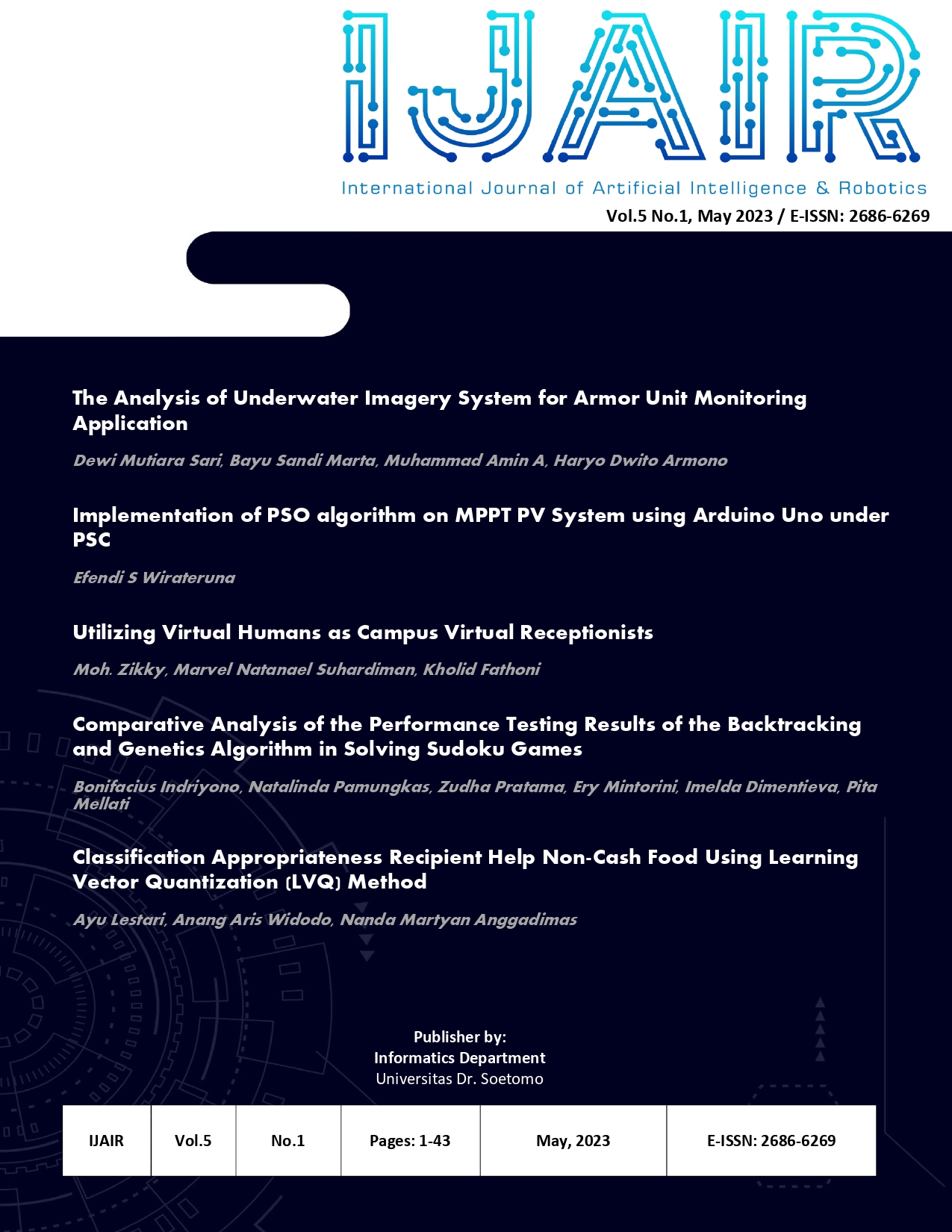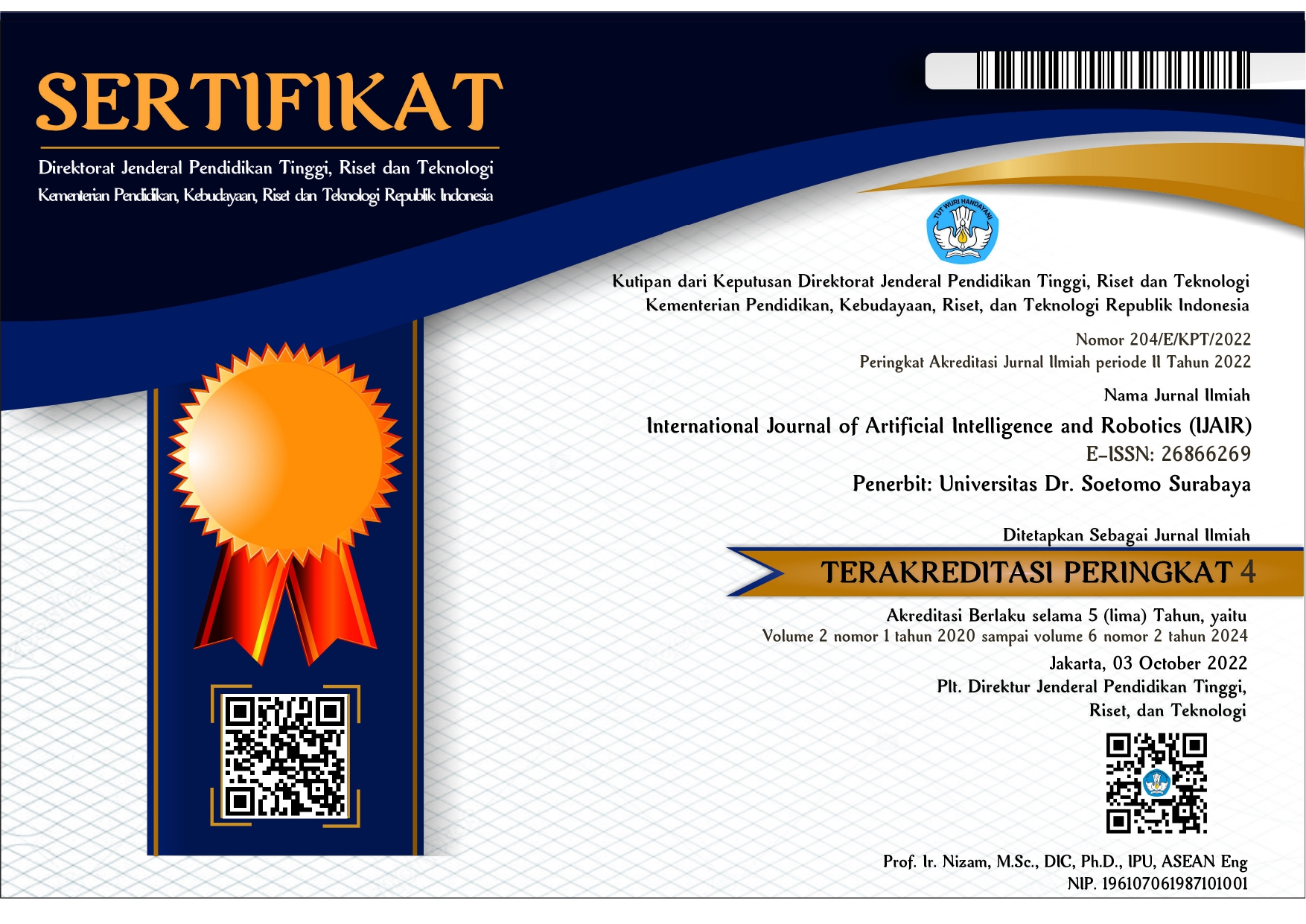Implementation of PSO algorithm on MPPT PV System using Arduino Uno under PSC
 Abstract views: 443
,
Abstract views: 443
,
 PDF downloads: 382
PDF downloads: 382
Abstract
The availability of fossil energy sources decreases as consumers' demand for electrical energy increases rapidly. Currently, the utilization of renewable energy sources is crucial. PV is a renewable energy source that converts photon energy into DC current. Maximum power point tracker (MPPT) control technology for photovoltaics has advanced significantly. PV is unique in that its P-V characteristic curve is non-linear. Conditions of partial shading can cause the P-V curve to have multiple peaks. This research will design MPPT PV using the Particle Swarm Optimization (PSO) algorithm in partially shaded conditions with an Arduino Uno and boost converter. Conventional algorithms, incremental conductance (IC), and Perturb and Observe (P&O) are implemented as a comparison. The purpose of implementing the PSO algorithm is to find the global peak of power to minimize power losses of PV. It leads to optimal power in case of partial shading conditions. Two PV modules are arranged in series for MPPT in a partially shaded environment. The examination was conducted in a darkened room with spotlights. The mean absolute percentage error of the current sensor, INA219, and the voltage sensor, voltage divider, was less than 1% during testing. The MPPT PV system test results indicate that the PSO algorithm can extract approximately 1.64 Watts of average power. In contrast, the IC and P&O algorithms can extract about 1.25 Watts and 1.41 Watts, respectively. When no algorithm exists in the control system, the extracted power is approximately 1.13 watts. Thus, the PSO algorithm tracks global or optimal power under partial shading conditions.
Downloads
References
S. Erdogan, I. Okumus, and A. E. Guzel, "Revisiting the Environmental Kuznets Curve hypothesis in OECD countries: the role of renewable, non-renewable energy, and oil prices," Environmental Science and Pollution Research, vol. 27, no. 19, pp. 23655–23663, 2020, doi: 10.1007/s11356-020-08520-x.
A. Shahsavari and M. Akbari, "Potential of solar energy in developing countries for reducing energy-related emissions," Renewable and Sustainable Energy Reviews, vol. 90, no. C, pp. 275–291, 2018, [Online]. Available: https://EconPapers.repec.org/RePEc:eee:rensus:v:90:y:2018:i:c:p:275-291
V. S. Arutyunov and G. v Lisichkin, "Energy resources of the 21st century: problems and forecasts. Can renewable energy sources replace fossil fuels?," Russian Chemical Reviews, vol. 86, no. 8, pp. 777–804, Aug. 2017, doi: 10.1070/rcr4723.
A. Sayigh, "Up-date: Renewable energy and climate change," Renew. Energy Environ. Sustain., vol. 6, 2021, [Online]. Available: https://doi.org/10.1051/rees/2021004
B. Liu, C. Fu, A. Bielefield, and Y. Q. Liu, "Forecasting of Chinese Primary Energy Consumption in 2021 with GRU artificial neural network," Energies (Basel), vol. 10, no. 10, Oct. 2017, doi: 10.3390/en10101453.
A. Nur Nazilah Chamim et al., "Analysis of Potential Alternative Energy Sources for Electricity Conservation in Yogyakarta State Finance Building," Journal of Electrical Technology UMY (JET-UMY), vol. 3, no. 3, 2019.
K. Vansant et al., "Investigation Of Correlation Between Field Performance And Indoor Acceleration Measurements Of Potential Induced Degradation (PID) For C-Si Pv Modules," 2017. [Online]. Available: https://www.researchgate.net/publication/330398059
Y. Chaibi, M. Salhi, A. El-jouni, and A. Essadki, "A new method to extract the equivalent circuit parameters of a photovoltaic panel," Solar Energy, vol. 163, pp. 376–386, 2018, doi: https://doi.org/10.1016/j.solener.2018.02.017.
A. Chalh, A. el Hammoumi, S. Motahhir, A. el Ghzizal, U. Subramaniam, and A. Derouich, "Trusted simulation using proteus model for a PV system: Test case of an improved HC MPPT algorithm," Energies (Basel), vol. 13, no. 8, Apr. 2020, doi: 10.3390/en13081943.
M. J. Afroni, E. S. Wirateruna, and O. Melfazen, "An Experimental Study of Partial Shading Effects on the P-V Characteristic Curve," in 2022 11th Electrical Power, Electronics, Communications, Controls and Informatics Seminar (EECCIS), 2022, pp. 22–27. doi: 10.1109/EECCIS54468.2022.9902950.
E. S. Wirateruna, M. J. Afroni, and F. Badri, "Design of Maximum Power Point Tracking Photovoltaic System Based on Incremental Conductance Algorithm using Arduino Uno and Boost Converter," Applied Technology and Computing Science Journal, vol. IV, no. 2, pp. 101–112, 2022, doi: 10.33086/atcsj.v4i2.2450.
G. Santoso Putra and D. M. Yuhendri, “Implementasi Sistem Kendali MPPT Panel Surya Berbasis Algoritma Incremental Conductance,” 2020.
O. Melfazen, M. T. Alawiy, and D. Dewatama, “Implementaasi Maximum Power Point Tracker (MPPT) dengan topologi sepic pada pembangkit listrik tenaga surya,” JURNAL ELTEK, vol. 18, no. 2, p. 1, Oct. 2020, doi: 10.33795/eltek.v18i2.250.
M. Sarvi and A. Azadian, "A comprehensive review and classified comparison of MPPT algorithms in PV systems," Energy Systems, vol. 13, no. 2, pp. 281–320, 2022, doi: 10.1007/s12667-021-00427-x.
E. Bas, E. Egrioglu, and E. Kolemen, "Training simple recurrent deep artificial neural network for forecasting using particle swarm optimization," Granular Computing, vol. 7, no. 2, pp. 411–420, 2022, doi: 10.1007/s41066-021-00274-2.
N. Setyawan, E. A. Hakim, and Z. Zulfatman, “Signature Pso: Modified Particle Swarm Optimization Dengan Fuzzy Signature Dan Implementasi Pada Optimalisasi Kendali Lqr,” Multitek Indonesia, vol. 13, no. 2, p. 29, Jan. 2020, doi: 10.24269/mtkind.v13i2.2227.
Copyright (c) 2023 Efendi S Wirateruna

This work is licensed under a Creative Commons Attribution-ShareAlike 4.0 International License.
Authors who publish with International Journal of Artificial Intelligence & Robotics (IJAIR) agree to the following terms:
-
Authors retain copyright and grant the journal right of first publication with the work simultaneously licensed under a Creative Commons Attribution License (CC BY-SA 4.0) that allows others to share the work with an acknowledgment of the work's authorship and initial publication in this journal.
-
Authors are able to enter into separate, additional contractual arrangements for the non-exclusive distribution of the journal's published version of the work (e.g., post it to an institutional repository or publish it in a book), with an acknowledgment of its initial publication in this journal.
-
Authors are permitted and encouraged to post their work online (e.g., in institutional repositories or on their website) prior to and during the submission process, as it can lead to productive exchanges, as well as earlier and greater citation of published work.















